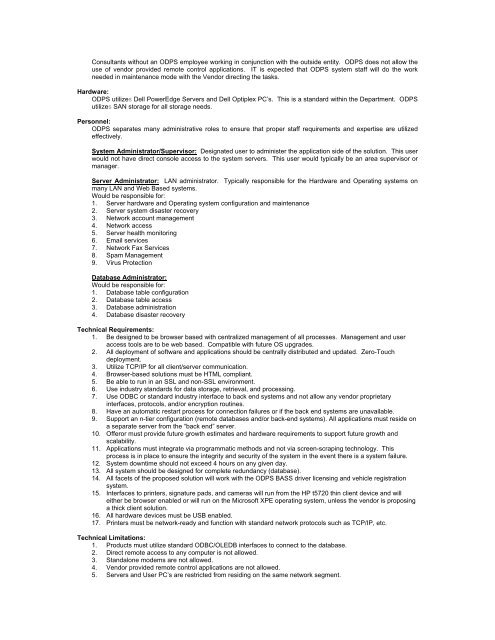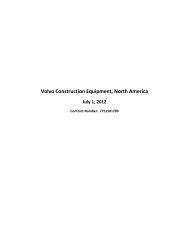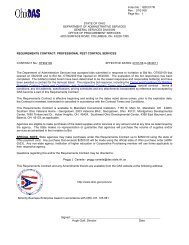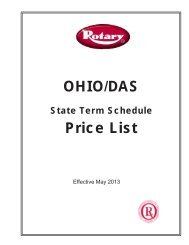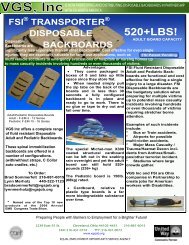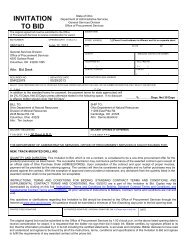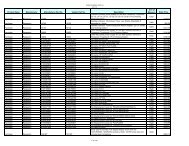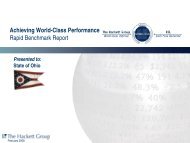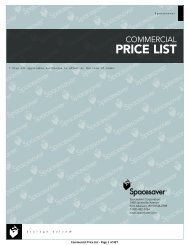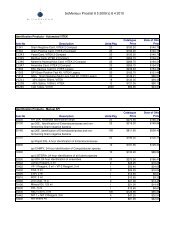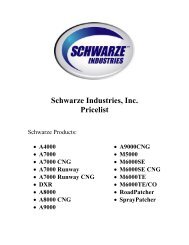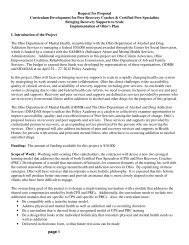REQUEST FOR PROPOSALS RFP NUMBER: 0A1031 DATE ISSUED
REQUEST FOR PROPOSALS RFP NUMBER: 0A1031 DATE ISSUED
REQUEST FOR PROPOSALS RFP NUMBER: 0A1031 DATE ISSUED
You also want an ePaper? Increase the reach of your titles
YUMPU automatically turns print PDFs into web optimized ePapers that Google loves.
Consultants without an ODPS employee working in conjunction with the outside entity. ODPS does not allow the<br />
use of vendor provided remote control applications. IT is expected that ODPS system staff will do the work<br />
needed in maintenance mode with the Vendor directing the tasks.<br />
Hardware:<br />
ODPS utilizes Dell PowerEdge Servers and Dell Optiplex PC’s. This is a standard within the Department. ODPS<br />
utilizes SAN storage for all storage needs.<br />
Personnel:<br />
ODPS separates many administrative roles to ensure that proper staff requirements and expertise are utilized<br />
effectively.<br />
System Administrator/Supervisor: Designated user to administer the application side of the solution. This user<br />
would not have direct console access to the system servers. This user would typically be an area supervisor or<br />
manager.<br />
Server Administrator: LAN administrator. Typically responsible for the Hardware and Operating systems on<br />
many LAN and Web Based systems.<br />
Would be responsible for:<br />
1. Server hardware and Operating system configuration and maintenance<br />
2. Server system disaster recovery<br />
3. Network account management<br />
4. Network access<br />
5. Server health monitoring<br />
6. Email services<br />
7. Network Fax Services<br />
8. Spam Management<br />
9. Virus Protection<br />
Database Administrator:<br />
Would be responsible for:<br />
1. Database table configuration<br />
2. Database table access<br />
3. Database administration<br />
4. Database disaster recovery<br />
Technical Requirements:<br />
1. Be designed to be browser based with centralized management of all processes. Management and user<br />
access tools are to be web based. Compatible with future OS upgrades.<br />
2. All deployment of software and applications should be centrally distributed and updated. Zero-Touch<br />
deployment.<br />
3. Utilize TCP/IP for all client/server communication.<br />
4. Browser-based solutions must be HTML compliant.<br />
5. Be able to run in an SSL and non-SSL environment.<br />
6. Use industry standards for data storage, retrieval, and processing.<br />
7. Use ODBC or standard industry interface to back end systems and not allow any vendor proprietary<br />
interfaces, protocols, and/or encryption routines.<br />
8. Have an automatic restart process for connection failures or if the back end systems are unavailable.<br />
9. Support an n-tier configuration (remote databases and/or back-end systems). All applications must reside on<br />
a separate server from the “back end” server.<br />
10. Offeror must provide future growth estimates and hardware requirements to support future growth and<br />
scalability.<br />
11. Applications must integrate via programmatic methods and not via screen-scraping technology. This<br />
process is in place to ensure the integrity and security of the system in the event there is a system failure.<br />
12. System downtime should not exceed 4 hours on any given day.<br />
13. All system should be designed for complete redundancy (database).<br />
14. All facets of the proposed solution will work with the ODPS BASS driver licensing and vehicle registration<br />
system.<br />
15. Interfaces to printers, signature pads, and cameras will run from the HP t5720 thin client device and will<br />
either be browser enabled or will run on the Microsoft XPE operating system, unless the vendor is proposing<br />
a thick client solution.<br />
16. All hardware devices must be USB enabled.<br />
17. Printers must be network-ready and function with standard network protocols such as TCP/IP, etc.<br />
Technical Limitations:<br />
1. Products must utilize standard ODBC/OLEDB interfaces to connect to the database.<br />
2. Direct remote access to any computer is not allowed.<br />
3. Standalone modems are not allowed.<br />
4. Vendor provided remote control applications are not allowed.<br />
5. Servers and User PC’s are restricted from residing on the same network segment.


